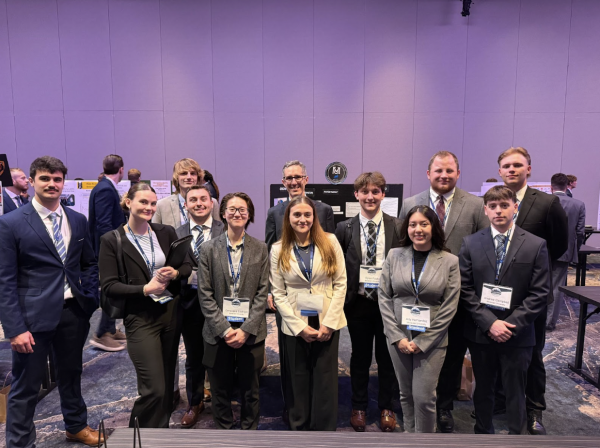Sharks, Sunbathing, and Science: My REU Experience

Photo courtesy of James Mecca
Research science is the fundamental aspect of all science.
When one hears the term “science,” especially someone with an outside perspective, it is often what they think of, the drive to pursue knowledge and the understanding of key concepts and ideas. To collect information to prove preconceived suspicions, or perhaps to come up with answers to questions still unasked.
What is the basic purpose of all life? Why do all of these animals engage in this activity? What does twenty pounds of defrosted squid smell like when you put it through a blender with gelatin? (Answer….well, not very good, but thankfully I wasn’t the one eating it.)

This past summer I traveled to Lewes, Delaware, where I created and conducted my own personal research project. This was done in tandem with the University of Delaware’s less known satellite campus, The College of Earth, Ocean, and Environment. All of this was orchestrated through the national REU program, or Research Experiences for Undergraduates, funded through the National Science Foundation.
I applied on a whim over last year’s winter break, the allure of research significantly less important to me than the allure of graduate school. As a prospective doctoral student of veterinary medicine, I needed the application leverage, and having research under my belt seemed like a distinguishing factor I could utilize.
When I was accepted into the program I had no research experience, and upon embarking on it over the summer, I had just three science-oriented collegiate level courses to my name. Needless to say, I was a bit terrified. The research program felt very legitimate while I, on the other hand, felt like an imposter in a lab coat.
I had very little idea of what to expect, what equipment was available to me, and what exactly I wanted to research. While some students came in with a ten-year research plan, I showed up with simply the desire to do research with animals.
The REU program seeks to give young and often inexperienced undergraduates the opportunity to conduct research and grow within their fields. The goal: to create future scientists.
The staff at the Lewes campus was very talented, their areas of interest vast and encompassing, but there was only one professor I truly wanted to work with: Dr. Aaron Carlisle, a marine biologist with a particular interest in elasmobranchs (sharks, skates, and rays). As a pre-veterinary student and natural animal lover, I was enthralled by the prospect of working with marine wildlife.
Luckily for me, I was paired with Dr. Carlisle, and with some more than gentle nudges in the right direction, I developed my research project, titled “Using Respirometry to Develop a Bioenergetic Model for Juvenile Mustelus Canis”.
Ten weeks over a summer is hardly enough time to solve global warming, ocean acidification, and the pileup of microplastics, so my world-saving ocean science would have to wait while I scaled down just this one time.
Mustelus Canis is more commonly known as the smooth dogfish shark or the dusky smooth hound. They’re an incredibly abundant bottom-feeding shark that ranges from the New England coastline of the Eastern United States all the way down to the Gulf of Mexico. Despite their abundance, there is much that is unknown about them, and much that is simply predicted using the data of their sharp-toothed relatives.
Due to this lack of information, studying them in an attempt to gather species specific data is increasingly important. Their small size and abundance make them ideal candidates for laboratory scientific research, as they are both easier to house and easier to find than great whites, which were my first choice. Our ideal candidates were YOY (young of year) sharks, or simply sharks that are younger than one year of age.
Summer, as it turns out, is a fantastic time to catch them. They reproduce heavily in the bays on the northeast before swimming south in the winter in search of warmer waters.
So, what exactly is respirometry? Or a bioenergetic model for that matter?
While you can have one without the other, they go together like the Office of the Provost and my email inbox.
Respirometry has slight variations in definition depending on the field and facet of study in particular. For marine biologists, it typically means the measurement of a species’ oxygen consumption, taken in order to determine its overall metabolism. And that is exactly what we did, via a massive tank, some machinery, and some sensors that have a combined cost of raising a child to adulthood.
Why measure metabolism? This is where the bioenergetic model comes into play.
A bioenergetic model is a fancy mathematical equation with more than a few variables. So, intrinsically it is every biologist’s worst nightmare. A bioenergetic model sets an organism’s consumption rates equal to their overall energy footprint. Essentially speaking, any living animal has to consume a set amount of energy (in various ways across species) in order to meet or exceed their daily, weekly, monthly, etc., energy requirements.
This allows them to complete energy excessive tasks like reproduce and grow, instead of just barely surviving, or worse, slowly dying. So naturally, this equation is important. It’s widely used in marine biology to determine the overall consumption rates of populations and thus predict their interactions with the immediate environment. It is also used by fisheries worldwide to predict the effects of their fishing of certain species on other species populations that might not have even been fished at all.
Calculating a species specific metabolic rate for Mustelus canis, instead of relying on the metabolic rate of a relative, offers the most accurate look at their consumption rates as a population. It also provides a working model for other scientists to manipulate and therefore predict changes based on the skewing of other variable energy costs.
So, over the span of ten weeks from June to August I cared for multiple sharks, took college sanctioned oceanic fishing trips, became a residential tank plumber, made a multitude of bright and driven friends, got chastised for hand feeding sharks, and conducted my experimentation.
My personal research involved just three sharks; though we had more in the lab, some were allocated for other people’s pursuits of knowledge. I carried these sharks from one room to another, like a father with his newborn child, and placed each of them in something called an intermittent flow respirometer or, as we called it in the lab, “the fish treadmill.” The respirometer is a fancy tank that circulates water around in a counterclockwise fashion and allows the sharks to swim in place.
It is completely closed off, so that no oxygen can enter the system, and overall dissolved oxygen measurements are taken from the water directly every ten seconds. As the shark swims freely in place, it pumps water through its gills, consuming the oxygen that is present. The declining oxygen levels are graphed over time, the slope gathered and a rate is determined.
Then comes the really fun part: the intermittent flow. The entire system is simultaneously flushed of the old water and refilled with brand new sea water. To the shark the amount of water never changes. Yet, with the new water, oxygen levels shoot back up to the starting high point while my fellow graduate student, Maria Sabando Plaza, and I rush around the tank turning knobs, cranking levers, and getting wet.
Each shark was put through three separate trials for a total of nine altogether.
Each individual shark’s three oxygen consumption rates were averaged, resulting in

three total rates, or one per shark. Then those three rates were averaged for one single rate, and all of that was converted into a metabolic rate in kJ/day.
Finally, it was plugged into a bioenergetic model with a multitude of other variables completed by a multitude of other scientists. So, after a painstaking few weeks, we were granted a generalized consumption rate for YOY smooth dogfish sharks.
It sounds easy when it’s put like that, but I likely lost a few inches from my hairline and had stress-induced cortisol levels so high that no meditation app known to man could’ve saved me. Yet, for once, we had an accurate metabolic rate for Mustelus canis, instead of one taken from a shark much larger, and much more active.
What started as a means to an end, a foothold into larger scale science, and a desire to get into graduate school quickly turned into an odd love affair.
I think research is something that every science major should explore, even if it isn’t directly related to their field. It’s fraught with important lessons to learn and experiences to enjoy. I cannot recommend the REU program at the University of Delaware enough and I encourage anyone, regardless of experience level, to look into the opportunities offered through the REU website and within SOAR at our own campus.
James Mecca is a sophomore biology major at Moravian University.






